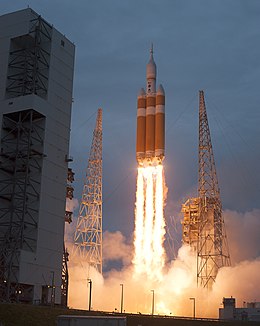 Launch of EFT-1 on 5 December 2014 | |
| Names | Orion Flight Test-1 (OFT-1) |
|---|---|
| Mission type | Technology demonstration |
| Operator | NASA |
| COSPAR ID | 2014-077A |
| SATCAT no. | 40329 |
| Mission duration | 4 hours, 24 minutes |
| Orbits completed | 2 |
| Spacecraft properties | |
| Spacecraft | Orion CM-001 |
| Spacecraft type | Orion |
| Manufacturer | Lockheed Martin |
| Start of mission | |
| Launch date | 5 December 2014, 12:05 UTC (7:05 am EST)[1][2] |
| Rocket | Delta IV Heavy |
| Launch site | Cape Canaveral, SLC-37B |
| Contractor | United Launch Alliance |
| End of mission | |
| Recovered by | USS Anchorage |
| Landing date | 5 December 2014, 16:29 UTC (8:29 am PST) |
| Landing site | Pacific Ocean, 640 mi (1,030 km) SSE of San Diego (23°37′N 114°28′W / 23.61°N 114.46°W) |
| Orbital parameters | |
| Reference system | Geocentric |
| Apogee altitude | 5,800 km (3,604 mi) |

| |
Exploration Flight Test-1 or EFT-1 (previously known as Orion Flight Test 1 or OFT-1) was a technology demonstration mission and the first flight test of the crew module portion of the Orion spacecraft. Without a crew, it was launched on 5 December 2014 at 12:05 UTC (7:05 am EST, local time at the launch site) by a Delta IV Heavy rocket from Space Launch Complex 37B at the Cape Canaveral Air Force Station.[3]
The mission was a four-hour, two-orbit test of the Orion crew module featuring a high apogee on the second orbit and concluding with a high-energy reentry at around 8.9 kilometers per second (20,000 mph).[4] This mission design corresponds to the Apollo 2/3 missions of 1966, which validated the Apollo flight control system and heat shield at re-entry conditions planned for the return from lunar missions.
- ^ Rhian, Jason (14 March 2014). "NASA's EFT-1 Mission Slips to December". SpaceFlight Insider. Archived from the original on 13 May 2016. Retrieved 7 December 2014.
- ^ Siceloff, Steven (5 December 2014). "LIFTOFF! Orion Begins New Era in Space Exploration!". Orion. NASA. Retrieved 7 December 2014.
- ^ Foust, Jeff (5 December 2014). "Delta 4 Heavy Launches Orion on Second Attempt". SpaceNews. Retrieved 24 February 2023.
- ^ Bergin, Chris (14 November 2011). "EFT-1 Orion Receives Hatch Door—Denver Orion Ready for Modal Testing". NASASpaceflight.com. Retrieved 16 November 2011.